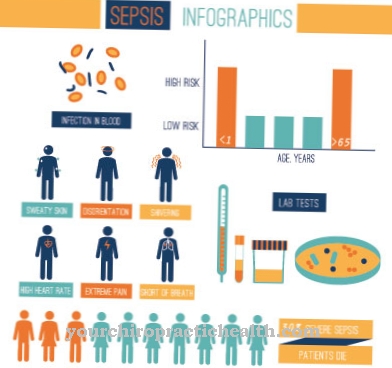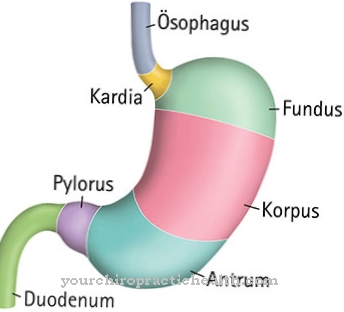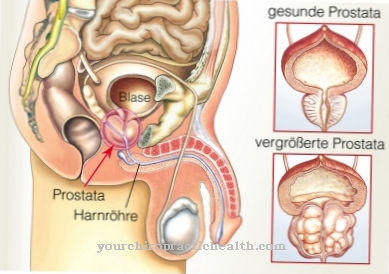COPD is an abbreviation for Chronic Obstructive Pulmonary Disease, so Chronic obstructive pulmonary disease. COPD comprises several similar disease patterns that have similar symptoms and symptoms. Severe shortness of breath, cough and sputum (cough phlegm) are typical. The main cause of COPD is smoking.
What is COPD?
.jpg)
Chronic obstructive pulmonary disease (COPD) is damage to the lungs that cannot be reversed (irreversible). The COPD consists almost principally of the chronic bronchitis ("smoker's cough"), the chronic bronchiolitis and the emphysema (destruction of the alveoli and thus a significantly reduced exchange surface for the gases).
A typical symptom is difficulty breathing during exhalation. During expiration the bronchi collapse or are blocked by thick mucus. This is known medically as obstruction. At the beginning of the disease, the shortness of breath only occurs in attacks under physical exertion, and later sometimes permanently at rest. Further symptoms are white to brownish sputum, especially in the morning, and an excruciating cough.
The chronic obstructive pulmonary disease is one of the widespread diseases in Germany, the incidence is still increasing.
causes
By far the most common cause of COPD (chronic obstructive pulmonary disease) is active but also passive cigarette smoking. Even former smokers can still develop chronic obstructive pulmonary disease. But the risk is much lower. The physical stimulus and toxins directly damage cells in the airways, but also cause and promote chronic inflammation.
The immune cells not only clear away toxic particles, but also damage the lung structure through self-digestion. General environmental pollution (e.g. from fine dust or degradation products from biofuels) is also a relevant cause of a chronic obstructive disease. Some authors even give it a similar status to smoking.
Rarer causes are occupational contact with hazardous substances (e.g. cotton or chemical substances), infections and eating habits (food containing nitrite seems to favor COPD). Alpha1 antitrypsin deficiency also leads to emphysema. This is a hereditary disease in which an enzyme is missing or reduced, which can limit the self-digesting enzymes.
Symptoms, ailments & signs
Due to the gradual progression of COPD, typical symptoms of the disease are often recognized late and the diagnosis is only made at a later stage. Typical symptoms of COPD include sputum, coughing, and shortness of breath, also summarized as "AHA" symptoms. Those affected have typically had a productive cough with thick phlegm for several months.
It mainly occurs in the morning after getting up and is difficult to cough up. The narrowing of the airways also leads to shortness of breath. The problems mainly manifest themselves in the exhalation. Patients have difficulty exhaling all of the air and a dry, wheezing sound can be heard when exhaling.
Initially, the shortness of breath occurs mainly under exertion, so-called exertional dyspnea, but in the course of the time it comes to more and more frequent dyspnoea even at rest. The patients suffer from increasing limitations in their physical capacity. As a result of the decreasing lung capacity, there is an increasing lack of oxygen in the body.
This shows up as a blue discoloration of the lips, tongue, fingertips or toes. Doctors call this cyanosis. Frequent viral infections and cigarette smoke worsen the symptoms of COPD (exacerbation) and thus promote the progression of the disease.
course
The sooner a COPD (chronic obstructive pulmonary disease) is diagnosed and treated by a doctor, the fewer complications there are and the disease can have a relatively good prognosis. Furthermore, the disease also depends on whether the person concerned quits smoking and actively carries out various rehabilitation measures.
Typical complications that can occur in the course of the disease are pneumonia or even lung cancer caused by smoking. In this context and in the event of inadequate treatment, heart failure or complete breathing failure can occur, resulting in death.
Complications
The progressive weakening of the lungs by COPD can lead to an increased colonization of bacteria and other pathogens. Further infections of the respiratory tract can occur more frequently as a result. The mucous membranes (especially those of the bronchi) no longer have the opportunity to counter the infection.
An acute worsening of the main symptoms of COPD is also possible at any time. The increased shortness of breath and the lack of oxygen cause cramping and, as a result, higher blood pressure and increased stress on the heart muscles. Both of these increase the risk of heart attacks and strokes considerably.
In addition, an acute exacerbation often requires treatment because the person concerned can no longer breathe at all. The purely structural damage to the airways caused by chronic obstructive pulmonary disease can lead to lung collapse. A pneumothorax can be very different and also represent an acute danger to life.
Nocturnal pauses in breathing, which can be associated with highly developed COPD, can lead to heart failure. Organs can be permanently damaged by the reduced blood flow. In addition, the heart can swell as a result of the poor supply of oxygen and ultimately fail completely.
When should you go to the doctor?
Given that COPD is one of the most common causes of death, it is advisable to see a doctor quickly. So if the typical symptoms - cough and shortness of breath - occur, no one affected should shy away from going to the doctor. Clarifying the symptoms makes sense. It is possible that it is a harmless infection, but chronic symptoms, long-term smoking or frequent exposure to harmful substances indicate chronic damage to the lungs.
The earlier COPD is recognized, the better it can be prevented from progressing. Correspondingly, the risks for the sequelae of a smoker's lung can be reduced, which, with consistent lung therapy, leads to an almost normal life expectancy with fewer restrictions.
The treating physicians are primarily the family doctor (to clarify infections and for the purpose of an initial examination) and a pulmonologist for the further treatment of COPD.
If COPD has already been diagnosed, it is advisable to have the attending physician check it regularly in order to change the therapy if necessary. If the condition deteriorates, a doctor must be consulted in any case.
Doctors & therapists in your area
Treatment & Therapy
The therapy takes place depending on the severity (stage) of the chronic obstructive pulmonary disease (COPD). The only goal is to improve symptoms. Attempts are also made to prevent or slow down the progression of the disease. The lung changes themselves are irreversible.
First and foremost are drugs that dilate the bronchi. These are usually inhaled when breathlessness occurs and take effect quickly. Typical representatives of this group are the short-acting beta-2 sympathomimetics (e.g. salbutamol), anticholinergics (e.g. ipratropium bromide) and methylxanthines (theophylline, reserve drug). A combination of drugs from different groups of active ingredients is possible. If the medication is insufficient, long-acting beta-2 sympathomimetics (e.g. salmeterol) are added.
Glucocorticoids (e.g. budesonide) are used from stage three or when the condition deteriorates - usually triggered by an infection (exacerbation). These can be administered inhalatively, in acute cases also systemically as a tablet or intravenously. Long-term systemic cortisone therapy does not make sense in chronic obstructive pulmonary disease. In addition, antibiotics should be used in the case of infections, as inflammation in the sense of an exacerbation can massively worsen the symptoms. The effectiveness of expectorants (e.g. acetylcysteine (ACC)) could not be proven.
Physical measures are also helpful, e.g. Use of the auxiliary breathing muscles in the so-called coachman's seat or breathing exercises for more breath control (brake lips when exhaling). If these measures are insufficient (stage four), the patient is supplied with oxygen. Portable oxygen devices can be easily integrated into everyday life. A distinction is made between long-term treatment and interval treatment.
If the disease progresses, the respiratory muscles can no longer cope with the increased work and can exhaust them. The affected person must then be fully ventilated as part of home ventilation. Interval therapy is also possible here. However, weaning from ventilation is usually only realistic if there has been an exacerbation. Surgical procedures (lung volume resection for emphysema, lung transplantation) are the last item in therapy.
Outlook & forecast
The prognosis for COPD is usually considered unfavorable. It depends largely on whether and to what extent the course of the disease can be influenced. If you succeed in slowing the progression of the disease significantly, the chances of improvement increase. On average, however, the life expectancy of patients with COPD falls by up to 5-7 years in direct comparison with healthy people.
The cooperation of the patient is essential for improving health. The consumption of pollutants must be avoided completely. This includes a cessation of smoking as well as the consumption of other toxins. If the patient is exposed to nicotine, exhaust fumes or other harmful substances from the craft or construction industry, their chances of recovery are significantly reduced. At the same time, the disease progresses faster. As soon as the lung tissue of the COPD patient has been damaged only minimally, the prospect of an alleviation of the symptoms or the chance of recovery increases. However, this is only possible in a few patients.
In most cases, tissue damage to the lungs of COPD patients is advanced and cannot be repaired. Often the only way to improve health is through a donor lung and thus a transplant. Nevertheless, a further progression of COPD can be prevented with a drug therapy and the renouncement of harmful substances.
prevention
The best prevention is to quit smoking or not to start smoking in the first place. But passive smoking must also be consistently avoided. Upper respiratory tract infections should be treated consistently to avoid the onset or worsening of the chronic obstructive pulmonary disease.
Aftercare
Various follow-up methods can be considered for chronic obstructive pulmonary disease. These depend on the extent to which the lungs could be relieved and what effects the disease had and is having on the body and psyche of the person affected.
For example, those affected by COPD can make use of psychological counseling and self-help groups. This is especially valuable if the disease is no longer treatable or has led to severe restrictions. This can be caused by a disorder of the skin as a result of the illness or by an all-round reduced performance.
For all forms of mild and moderate cases of COPD that require inpatient treatment, various forms of physical follow-up can be considered. Light training (walking, climbing stairs, etc.) and going to places with clean air are generally recommended. Follow-up care also includes regular breathing exercises. Keeping the body healthy (especially when it comes to being overweight) is also part of aftercare.
Those affected by chronic obstructive pulmonary disease must also undergo regular follow-up examinations. Here the lung function and structure are recorded and progress or setbacks are determined. If the lungs are severely damaged, lifelong follow-up examinations can be assumed.
You can do that yourself
In order to regain strength after a diagnosed COPD and to maintain independence and mobility despite the illness, those affected have many options. In addition to absolutely avoiding cigarettes, an everyday life that hardly contains any pollutants in the air should also be aimed for. This includes avoiding dusty rooms, chemical fumes and busy roads.
Regular walks in the fresh air as well as suitable sport - this must be selected with the attending physician - are advisable. This cleanses the lungs and increases breathing performance. Applied breathing techniques such as brake lip can also improve breathing.
As your breathing becomes increasingly strenuous as COPD progresses, you may need to change your diet. For example, food should be particularly rich in vitamins and minerals, so that cell renewal in the bronchi and mucus formation can strengthen the immune system. Sufficient amounts of fluid and tea make it easier to cough up sputum.
In order to relax the lungs and at the same time loosen the mucus, steam inhalations have proven themselves. Mint, eucalyptus, thyme and sage are oils often used here.
Installing an air filter in frequently used rooms can also protect the lungs from further particles. With increasing weakness due to shortness of breath, everyday aids (gripping aids on the bathtub and the like) should be installed.





.jpg)


















.jpg)



